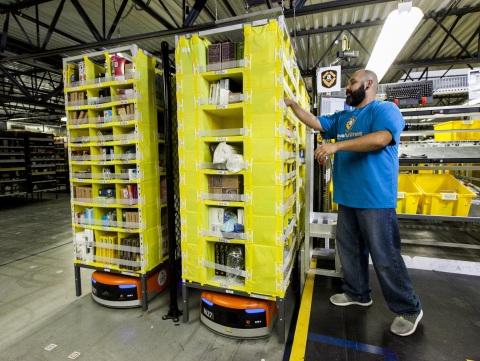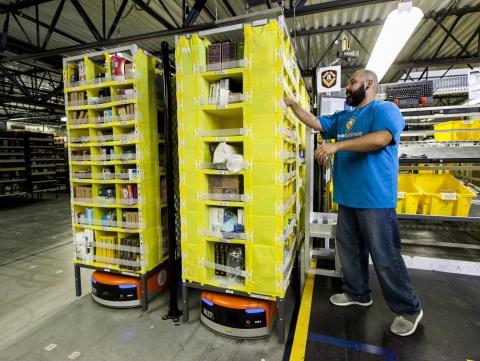Amazon Says Expansion Worth PriceAmazon Says Expansion Worth Price
After a Moody's credit rating downgrade, Amazon will pay a higher rate to borrow than well-funded competitors, such as Apple, Microsoft, and Google, but says business expansion will pay.


Holiday Gift Guide 2015: What Techies Want
Holiday Gift Guide 2015: What Techies Want (Click image for larger view and slideshow.)
As it moves towards the end of its peak revenue quarter, Amazon.com remains more committed to expanding its business than the possibility of showing a profit. As it prepared to borrow for more expansion last week, Moody's Investor Service lowered Amazon's rating from "stable" to "negative" and gave Amazon a Baa1 rating for borrowing.
Amazon has been able to use the substantial cash flow produced by its quarterly growth in sales to build out parts of its business, such as its 10 modern, robotic distribution centers or its rapidly growing Amazon Web Services cloud infrastructure. Amazon's revenues from AWS have always fallen under its non-specific "other" category, and Moody's cited Amazon's recently announced plan to offer debt, combined with "lack of visibility" on how the funds would be deployed, as reasons for the downgrade.
The size of Amazon's new senior unsecured notes has not yet been determined, said Moody's VP Charlie O'Shea in a news release Dec. 1. It is the financial services company's expectation that the funds will be used for corporate purposes that will support growth initiatives, rather than for shareholder returns.
[Want to learn more about how Amazon manages AWS? See Amazon Cloud: 10 New Insights.]
In a year in which stocks on the Nasdaq have risen 18%, Amazon has fallen 14% as investors become less enamored with its expansionist business strategy, Reuters reported Dec. 2.
Other voices have warned that Amazon will face increasing competition as old-guard retailers, such as Walmart, Target, Best Buy, and Home Depot, find their footing on the Web and start offering holiday bargains on their sites. Brian Sozzi of Belus Capital Advisors said Amazon.com, as a pioneer of Web shopping, "for years had the advantage of getting you the lowest possible price on a mobile device." It would face increasing competition in doing so, he told Reuters.
Figure 1:  Amazon employee picks items from a Kiva robot in its Seattle distribution center. (Source: Amazon, via Business Wire)
Amazon employee picks items from a Kiva robot in its Seattle distribution center. (Source: Amazon, via Business Wire)
Amazon.com CEO Jeff Bezos appeared relaxed the day after the Moody's downgrade and talked about the stock price at a New York event organized by Web publisher Business Insider. He defended Amazon's business strategy, which is producing $70 billion a year in revenue, as one of a young company willing to engage in risk taking. One such initiative this year was the launch of its poor-selling Fire Phone. "We are a large company, but we are also still a startup. There is a lot of volatility in startups," Bezos said at the Dec. 2 event.
Amazon could make more money on its cloud services if it weren't so aggressively pushing down the price of its service. Its free Trusted Advisor service is an automated review of customer's account configurations, followed by guidance on how the customer could save money. Trusted Advisor has issued 2,613,585 recommendations in 18 months, and customers acting on them have trimmed $350 million from their monthly bills, according to figures presented by senior VP Andy Jassy at AWS's Re:Invent conference last month.
At the same time, Amazon's approach with Trusted Advisor and periodically lowered prices keep its customer base largely intact. AWS cloud services
are growing at a rate of 40% a year; virtual server use jumped 99% in 2014 compared to the year before; and S3 storage is up 137%, Jassy said at Re:Invent.
AWS announced Dec. 4 it cut pricing on data-transfer services by 6% for the first 10 TB and by 25% for the next 40 TB. AWS spokesmen called it Amazon's 47th price cut in cloud services. Cuts in some Asia regions, where Amazon wants to make up lost ground to Microsoft (which offered services from China before Amazon did), were as high as 37% in the Singapore region for the first 10 TB and 43% for the next 40 TB. In Tokyo, the cuts were 30% and 15%, respectively; Sydney, Australia, saw cuts of 26% and 21%, respectively.
During Re:Invent, Jassy was asked whether Amazon would be able to continue to compete by cutting prices and expanding into robotic distribution centers. Amazon currently has 10, but plans to build more. Highly profitable businesses, such as Microsoft and Google, are also cutting their cloud service prices. How much longer can Amazon compete on the price front, Jassy was asked.
He responded that Amazon can see that startups like its AWS infrastructure. Amazon now has a team that does nothing but talk to startups and members of the venture capital community. It runs a pop-up loft in San Francisco's Market Street where startup representatives can drop by and ask questions about using AWS infrastructure or test drive the cloud. "We were totally blown away by how many people came to talk to us," he said at Re:Invent.
At the same time, AWS is seeing more interest from established enterprises. Not surprisingly, AWS officials believe their unit represents the future data center for many of these businesses. "We are just at the beginning of a titanic shift. More of these on-premises-to-cloud transitions will be taking place over the next several years."
"When you have an opportunity like this -- there are not many like this in one lifetime -- you invest what it takes," he said. If Amazon is correct and the center of gravity of its business is shifting toward more mature enterprises, then that will help sustain Amazon expansion. "Enterprises spend more total dollars than startups. That's the nature of their business," Jassy observed.
Media reports said it would cost $1 billion to add a cloud data center in a new region of the world, and some have predicted Amazon is no longer in a position to spend that money. But Jassy disagreed, saying Amazon can continue to add regions. He declined to identify a cost per region but said the $1 billion estimate "is wrong."
Amazon might slow its expansion if it's forced to borrow money to do so. It might also slow its expansion if it has to borrow at higher rates than its competitors, as the Moody's rating would appear to suggest. On the other hand, its competitors have nowhere near the data center infrastructure or customer base that Amazon has, considered to be five times higher than its 14 closest rivals combined.
Knowing that he's already got that position, Jassy tends not to be concerned by short-term problems, like a Moody's rating. Cloud computing is "the biggest technology shift in our lifetime," he said at Re:Invent Nov. 12. If Amazon can translate early enterprise success into an increasingly rich revenue stream, Amazon shareholders may be persuaded it's worth the wait for profits. If that rich stream never materializes, then Jassy will have more to worry about than just a step down in the credit risk ratings. Right now, time and the gathering appeal of the cloud appear to be on his side.
Our latest survey shows growing demand, fixed budgets, and good reason why resellers and vendors must fight to remain relevant. One thing's for sure: The data center is poised for a wild ride, and no one wants to be left behind. Get the Research: 2014 State Of The Data Center report today. (Free registration required.)
About the Author
You May Also Like






